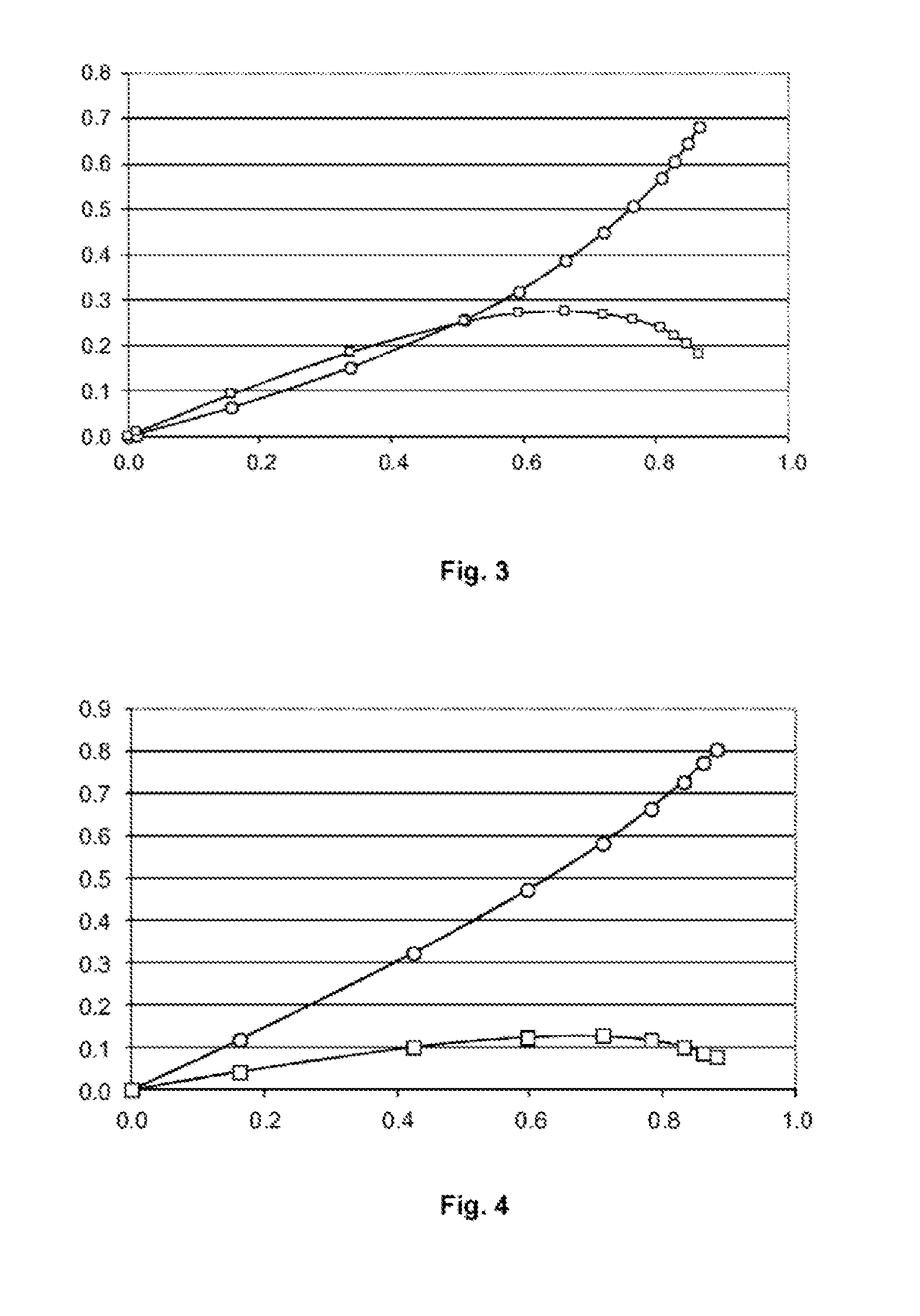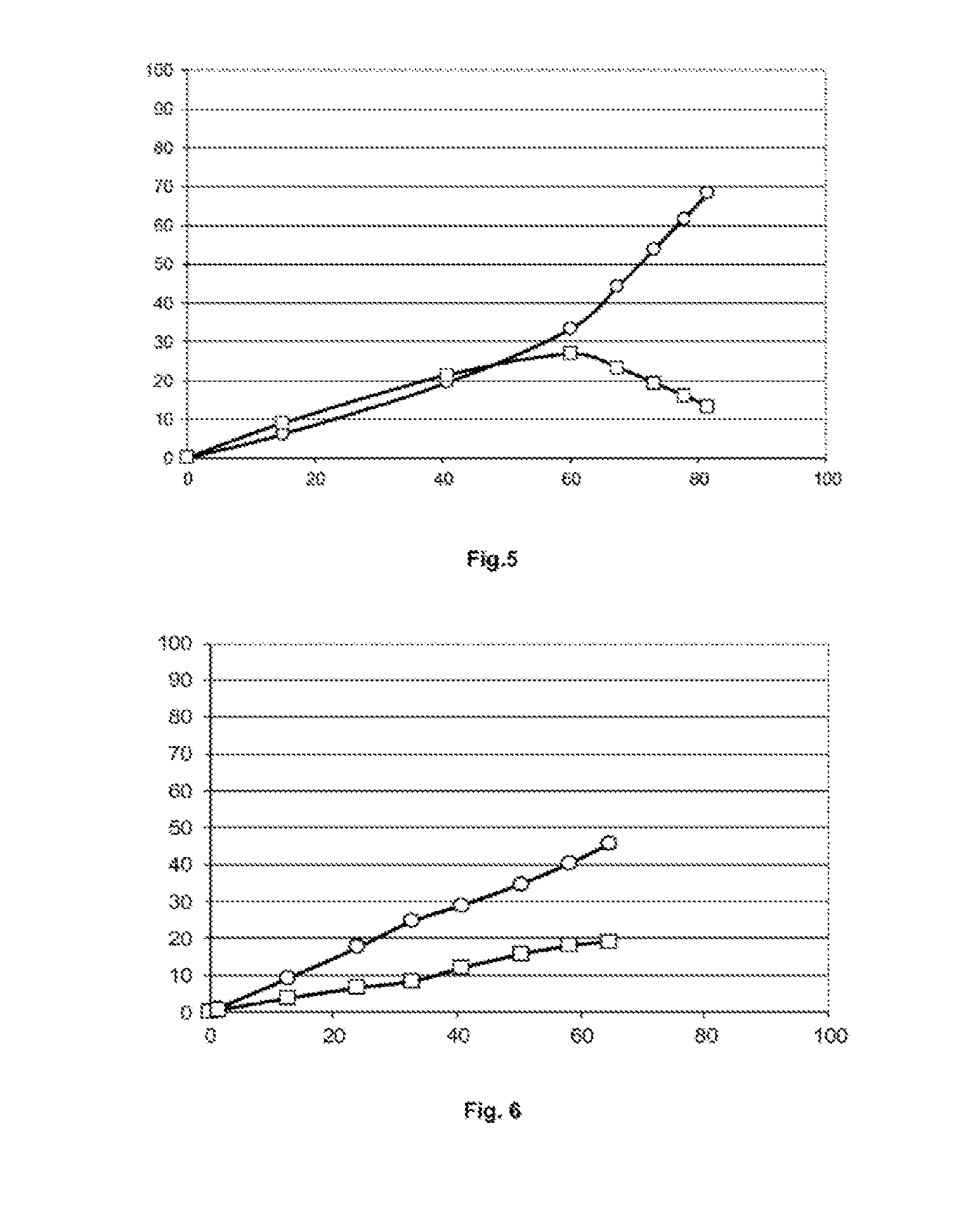Cross metathesis process
- Summary
- Abstract
- Description
- Claims
- Application Information
AI Technical Summary
Benefits of technology
Problems solved by technology
Method used
Image
Examples
example 1
Methyl 9-Decenoate / Acrylonitrile Cross Metathesis, Reference Process
[0188]The following reaction is carried out:
[0189]using the M71-SiPr catalyst supplied by the company Umicore.
[0190]15 g of methyl 9-decenoate (81.4 mmol) prepared in accordance with example 1 of document US 2011 / 0113679, previously passed over an alumina column, 2.15 g of acrylonitrile (40.7 mmol) and 150 g of toluene dried on molecular sieve are charged to a 250 ml glass reactor equipped with a condenser and purged with nitrogen. The mixture is heated to 110° C. and 2.6 g of acrylonitrile (49 mmol) and 2 mg of M71-SiPr catalyst (2.44×10−6 mol) dissolved in 5 g of toluene are added via syringes mounted on syringe drivers, over a period of 2 hours. Samples are taken every 30 minutes for analysis by gas chromatography. The conversions of the methyl 9-decenoate (MD) and the yields of C11 unsaturated nitrile-ester (NE) and of C18 unsaturated diester (DE) are reported on the graph of FIG. 3.
[0191]It is noted that, to ob...
example 2
Methyl 9-Decenoate / Acrylonitrile Cross Metathesis, Reference Process
[0198]The reference process is repeated for the cross metathesis between methyl 9-decenoate and acrylonitrile with another catalyst, namely the Hoveyda-Grubbs 2 catalyst (supplied by the company Aldrich).
[0199]15 g of methyl 9-decenoate (81.4 mmol) previously passed over an alumina column, 2.15 g of acrylonitrile (40.7 mmol) and 150 g of toluene dried on molecular sieve are charged to a 250 ml glass reactor equipped with a condenser and purged with nitrogen. The mixture is heated to 110° C. and 2.6 g of acrylonitrile (49 mmol) and 5.1 mg of Hoveyda-Grubbs 2 catalyst (8.1×10−6 mol) dissolved in 5 g of toluene are added via syringes mounted on syringe drivers, over a period of 2 hours. Samples are taken every 15 minutes for analysis by gas chromatography. The conversions of the methyl 9-decenoate (MD) and the yields of C11 unsaturated nitrile-ester (NE) and of the C18 unsaturated diester (DE) are reported on the graph...
example 3
Methyl 9-Decenoate / Acrylonitrile Cross Metathesis, Process According to the Invention
[0207]The cross metathesis reaction is carried out using successively the M71-SiPr catalyst and then the Hoveyda-Grubbs 2 catalyst, under the same conditions as examples 1 and 2.
[0208]15 g of methyl 9-decenoate (81.4 mmol) previously passed over an alumina column, 2.15 g of acrylonitrile (40.7 mmol) and 150 g of toluene dried on molecular sieve are charged to a 250 ml glass reactor equipped with a condenser and purged with nitrogen. The mixture is heated to 110° C. and 1.3 g of acrylonitrile (25 mmol) and 1 mg of M71-SiPr catalyst (1.22×10−6 mol) dissolved in 5 g of toluene are added via syringes mounted on syringe drivers, over a period of 1 hour.
[0209]The reaction is then continued by adding, over a period of 1 hour, 1.3 g of acrylonitrile (25 mmol) and 1.5 mg of Hoveyda-Grubbs 2 catalyst (2.45×10−6 mol) dissolved in 5 g of toluene.
[0210]The conversions of the methyl 9-decenoate (MD) and the yield...
PUM
| Property | Measurement | Unit |
|---|---|---|
| Fraction | aaaaa | aaaaa |
| Fraction | aaaaa | aaaaa |
| Fraction | aaaaa | aaaaa |
Abstract
Description
Claims
Application Information
 Login to View More
Login to View More - R&D
- Intellectual Property
- Life Sciences
- Materials
- Tech Scout
- Unparalleled Data Quality
- Higher Quality Content
- 60% Fewer Hallucinations
Browse by: Latest US Patents, China's latest patents, Technical Efficacy Thesaurus, Application Domain, Technology Topic, Popular Technical Reports.
© 2025 PatSnap. All rights reserved.Legal|Privacy policy|Modern Slavery Act Transparency Statement|Sitemap|About US| Contact US: help@patsnap.com



